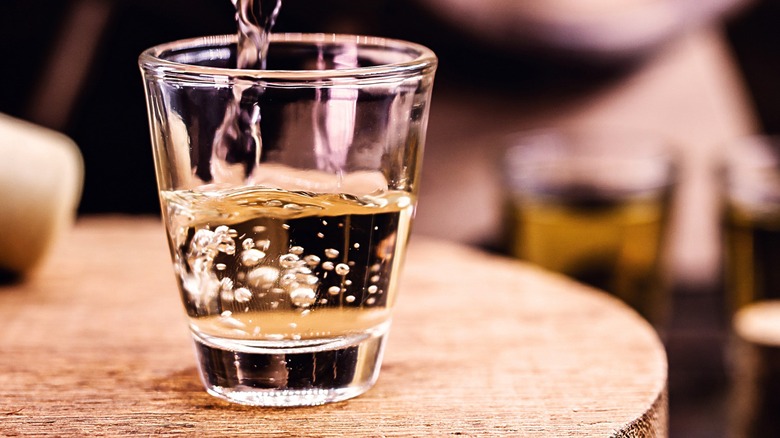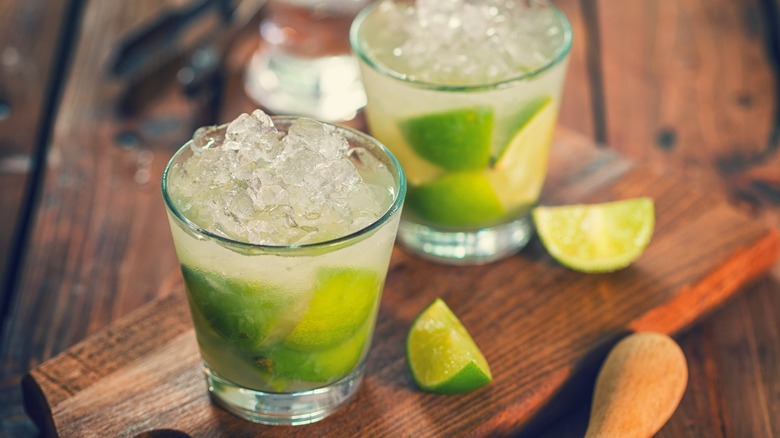Can You Drink Cachaça Straight?
Cachaça is a rum-adjacent spirit made from pressing and fermenting fresh sugar cane juice. You could think of it as rum-meets-tequila, but even this reference frame is wildly reductive. Cachaça is nothing if not distinctive, featuring a grassy, vegetal taste with major funk and slight sweetness. Top notes include leather, wood, grass, candied banana, and sourdough bread. The spirit typically clocks in at a full-proof 40% to 50% alcohol by volume (ABV), or 38% to 54% ABV per Brazilian regulations.
It can be unaged (branca) or matured to a golden hue (amarela), which takes place in barrels made from American or French oak, or Brazilian hardwoods such as amburana, cabreúva, tapinhoã, araribá, jequitibá, or teak wood. Brazilian hardwoods are indigenous to hot, humid climates, naturally repel insects, and impart an earthy terroir to the brew within, rounding out the aroma and softening cachaça's sharp, heady flavor. As with any spirit, cachaça can be drunk straight, and the higher the quality of your cachaça, the better your sipping experience will be.
Sipping it straight allows the complex, dimensional spirit to shine without being overshadowed by other ingredients. If your preferred way to enjoy cachaça is straight or on the rocks, it might be worth it to splurge on a top-shelf brand like Avuá (which has tasting notes of vanilla and butterscotch and is aged in French oak) or Bossa (which has smoky, spicy, cigarette, and candied fruit notes). Otherwise, if you primarily use cachaça as a cocktail ingredient, a mid-priced brand like Cabana (with floral and vanilla custard notes) or Leblon (with pear, molasses, and lime notes) should get the job done.
Accept no substitutes, cachaça is its own thing
Just as tequila is produced exclusively in Mexico, cachaça is a Brazil-exclusive product. The country is home to at least 3,000 official distilleries, and roughly 30% of the national output is made by small-batch producers. Collectively, Brazil cranks out an average of 800 million liters of cachaça every single year. A longtime favorite in the South American country, the spirit has recently expanded to a global fanbase, particularly in the U.S. and Portugal. June 12 is even celebrated as International Cachaça Day.
Per the lore, cachaça is likely the invention of 1800s Brazilian farmers, and, indeed, the agricultural spirit showcases the local sugarcane crop, regional geography, and Brazilian history. Whatever its exact origin, today, cachaça is the national spirit of Brazil (and feijoada is the country's national dish). For discerning sippers looking to get into cachaça but not super keen on drinking the spirit straight, try it in the iconic Caipirinha cocktail, a stripped-down three-parter that lets the cachaça shine.
A Caipirinha is made with just cachaça, lime, and sugar. Or, you could invest in a bottle of the spirit for your home bar and put the ingredient to good use in other cocktails like the Rabo de Galo ("tail of the rooster" in Portuguese) — which features cachaça, sweet vermouth, and Cynar — or the Lavarello, which is made with cachaça, Aperol, Cynar, and chocolate bitters. Pair any of these drinks with chicharrones and dip for the ultimate bar snack.

